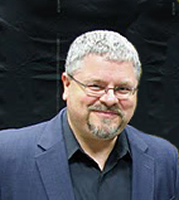Frequently there will be a work programmed on a concert that is so markedly different that it not only calls attention to itself, but actually recalibrates how the rest of the concert’s music is heard. Such was the case with not one but two works on the Peabody Trio‘s concert at the Unitarian Universalist Church of Asheville, an event sponsored by the Asheville Chamber Music Series. A work by post-Shostakovich Soviet composers Sofia Gubaidulina and Alfred Schnittke respectively led each half of the program, and each threw down a sort of sonic gauntlet, exposing revolutionary sound worlds that invited stillness and contemplation of the raw materials of music. And, by boldly programming each of these works as “starters,” the Trio helped make the case for a sympathetic hearing of these works on their own merits.
Violinist Violaine Melançon, cellist Natasha Brofsky, and pianist Seth Knopp comprise the Peabody Trio which won the prestigious Naumburg Chamber Music Award in 1989, and debuted in 1990 in Alice Tully Hall. They have been the resident faculty ensemble of the Peabody Conservatory in Baltimore since 1989. They maintain an active performance schedule at festivals and other venues around the world, and have an impressive list of recordings. As this program indicates, they are equally at home in the worlds of traditional and contemporary works.
The program opened with Gubaidulina’s “Dancer on a Tightrope” for violin and piano (1993), a piece in which the pianist’s music for the first half is generated from within the instrument by manipulation of the strings with a glass and the fingers. Occasionally its crescendos created such explosive booms that one was grateful for the remarks made beforehand that no harm would come to the instrument. The violin was consigned at first to very limited gestures — i.e., spiccato bowing that sounded like stuttering on a single pitch (this repeated over and over), a simple exploration of a gradation of intervals — ones that became more virtuosic as the work evolved. By the second half of the piece the pianist was at the keyboard, offering sustained chords whose harmonic rhythm was rather slow, a platform against the almost frantic, “gypsy-like” figures in the violin. These were decidedly two planes of activity, but ones which sustained a high level of unresolved tension. The music kept the listener mesmerized “in the moment,” as the familiar signposts that allow anticipation of events were missing.
When the Brahms Trio No. 2 in C, Op. 87 (1880-82) followed, its sustained melodies in familiar contours and rippling piano chords came with their own shock value — all that sweetness and Romantic yearning! Within its four movements, the violin and cellist frequently played as a homorhythmic pair, with the piano a related but separate entity. The pianist never overpowered the other players but matched their dynamic levels. The second movement Andante con moto, a charming set of five variations, showcased some of the most sensitive playing in this work — the ensemble was as fine as any I’ve heard (accomplished though the cellist sat with her back to the pianist). There was a finely tuned unity of interpretation of each phrase, each mood, and each cadential approach. The third movement Scherzo: Presto owed its debt to Mendelssohn with its elfin scherzo lightness and mysterious rustlings at the onset. The fourth movement was noteworthy for its rhythmic incisiveness as well as its gorgeous melodic passages.
Alfred Schnittke’s “Stille Musik” (1979) for violin and cello led the second half after an intermission, an intriguing work of incessant, dissonant statements which dissolved into the realm of wailing harmonics on each instrument, ethereal and creepy, like disembodied souls. As the pianist was already seated prior to the beginning of this piece and the performers had requested that the audience refrain from applause between works, this served as a sort of ghostly prelude to the Mendelssohn Trio in D minor, Op. 49 (1839). Due to the trio’s placement at the program’s end, I couldn’t help but be struck by its classical traits of balance and symmetry relative to what had come before. The second movement, an achingly beautiful song without words, was the emotional heart of the work and the players delivered some of their most impassioned playing here. The difficult finale demanded all the energy, technical fire, and concentration they could muster — they delivered, and more, eliciting a rousing ovation from this nearly full house.











